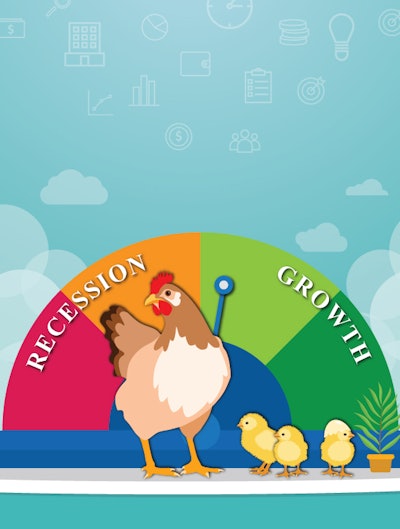
While 2021 should see improvements not only for the global broiler industry but for the world economy as a whole, there will be no overnight changes. Quarterly economic growth rates may appear high, but the world’s economies are rebuilding from huge contractions, with some saying that the economic emergency has only just begun. In such circumstances, any growth for poultry should be welcomed.
In late October 2019, the International Monetary Fund (IMF) estimated that the world economy would end 2020 at 4.4% smaller than it started. Its predictions to the end of 2021 suggest that the global economy could end the year at only 0.6% above its 2019 level.
While its forecasts may have been made before a number of positive vaccine announcements, vaccines will not offer an overnight solution. Businesses will continue to close and unemployment rise. In short, 2021 will be a year of continued difficulties.

While the impact of COVID-19 may lessen this year, it will continue to disrupt the market. | Andrea Gantz
What does all of this mean for the global broiler industry? As the cheapest meat, chicken is always best placed to weather consumers’ reduced circumstances. However, there will be other factors that will impact the industry, including rising costs, changing consumer purchasing habits, and politics.
The U.S. Department of Agriculture (USDA) believes that global chicken meat production will rise by 2% this year to stand at 103.9 million metric tons. Global trade in chicken meat, it believes, could reach a record 12.2 million metric tons, also an increase of 2%. Its forecasts, also made in October 2019, suggest, however, that growth will be far from even, with markedly different growth rates in individual markets
North America
The USDA believes that U.S. chicken meat production will rise by 1% in 2020 to reach 20.5 million metric tons, while U.S. exports will remain unchanged.
In November of 2019, banking and financial services company Rabobank, in its Global Animal Protein Outlook, noted that production cuts had helped to stabilize U.S. prices, but added that margins were not expected to improve greatly this year. Ongoing low prices, together with rising feed costs, would limit chicken production during the first half, however, volumes, it said, should increase in the second half.
Until consumer demand in North America improves, growth in total production will remain moderate, expanding by only 0.9% year on year, it says, noting also that Mexican producers similarly cut production during the second half of 2020.
Rabobank adds that demand for dark meat will gradually improve as the year progresses, particularly as foodservice begins to return to normality and export markets gradually improve.
Despite COVID-19 disruptions, U.S. poultry exports are thought to have reached a record high in 2020, largely driven by demand from China. At the same time, however, U.S. leg quarter sales in key markets fell, but higher prices for quarters are expected to emerge during the first six months of this year.
The USDA believes that U.S. chicken meat exports, at 3.3 million metric tons, will be at a similar level this year to those of 2020.
Brazil
Brazil is expected to produce and export slightly more broiler meat this year.
Production and domestic consumption are both forecast to rise by 1%, according to Rabobank, while the country’s Institute of Applied Economic Research (IPEA) forecasts that livestock production as a whole will expand by 4.4% in 2021, led by beef and poultry.
While a recovering economy should foster higher levels of demand in Brazil’s home market, producers will have to face continuing high feed prices. In November, IPEA noted that the sector had been working with record high feed ingredient prices, which had been squeezing margins, adding that reducing production would help to improve broiler producers’ margins.
Brazilian poultry exports grew last year, but the rate of growth lagged that recorded by its other meat exports. For the first 10 months of the year, Brazilian Association of Animal Protein notes that, by volume, exports increased by only 0.2%.
Late in the year, demand from Saudi Arabia rose sharply, following a period of weakness, boding well for the year ahead. However, demand from Brazil’s main export market, China, is expected to weaken this year as competition and local production increase.
The USDA believes that, during the year ahead, Brazilian shipments to the Middle East and Sub-Saharan Africa will rise, and that Brazil will account for over a third of global export growth.

It will be in retail, rather than restaurants and catering, where demand for chicken meat this year. | Sorbis | BigStock.com
European Union
Rabobank believes that the European Union (E.U.)’s poultry industry will be on the road to recovery this year but that the outlook remains highly uncertain.
The E.U. poultry industry has seen one of its most turbulent years. The decline in foodservice sales, representing 20-40% of distribution, shook the industry. Throughout 2020 the market was oversupplied, resulting in low prices, particularly for breast meat. Both intra-EU trade and exports fell.
As in other markets, the outlook for 2021 is highly dependent on COVID-19 developments, including government restrictions, the economic environment, and the return of foodservice. At the time of writing, the full impact of Brexit remained unknown.
Gradual improvements are expected, with 0.4% output growth in the E.U. and an increase of 1.5% in the U.K. European exports are forecast to rise by 4%, while those of the U.K. could grow by 2.3%.
Figures released by the European Commission prior to European countries implementing second lockdowns suggest that the bloc’s exports will rise by 1% this year, its imports increase by 6% and its consumption by 1.3%. The Commission notes that lockdowns in the Europe resulted in a shift in consumer demand away from other meats to poultry.
As 2020 drew to a close, Europe was experiencing an increasing number of outbreaks of avian influenza, with numerous countries losing their disease free status, supply disruptions and loss of export markets.
China
China has largely recovered from COVID-19, with its economy almost back at pre-crisis levels. Growth this year may even inch towards double digits, and it may also witness a change in its relationship with the U.S.
This, and expansionary government policy, should boost consumer spending, including on food.
China has expanded its breeding capacity over the last few years, and poultry production should continue to grow in 2021. This, however, is expected to be at a slower pace than that witnessed in 2020 and prices will come under pressure.
White feather birds are likely to record the strongest growth, despite over supply risks, in part, driven by a recovery in institutional purchasing.
The yellow feather industry was hit hardest by COVID-19 due to the closure of live bird markets, but the sector is expected to gradually expand this year.
China’s difficulties with African swine fever have benefited the poultry industry. However, as the swine industry recovers and is better able to supply China’s favorite meat, the benefits accruing to the broiler industry will fade.
Poultry imports are expected to decline this year, little surprise given their doubling in 2020.
South East Asia
South East Asia is expected to see limited growth this year, held back by Indonesia’s culling of parent stock and with strong variation from country to country.
COVID-19 had a major impact on the region and across Indonesia, Malaysia, the Philippines, Singapore and Thailand, poultry production and consumption are thought to have fallen by 6%. This year, expansion of 3% is expected.
Forecasts suggest that Indonesia will witness a 2% expansion, while the Philippines will grow by 3%, driven largely by domestic consumption.
Thailand’s chicken industry is expected to grow by 2%, driven by improvements in both its home and overseas markets. In Vietnam, expansion will be in the order of 6%, however, the recovery in the country’s pork industry may see domestic demand grow by only 4%.
India
After a difficult year in which consumer fears over COVID-19 harmed the poultry industry, 2021 should see a period significant growth – 13% is forecast. While under normal circumstances such growth would be deemed spectacular, this would only take India’s poultry output back to where it was at the end of 2019.
Larger poultry producers will be able to gain the most from the recovery and will benefit from investments in capacity expansion, feed manufacturing and new distribution methods.
Within retail, the formal sector will strengthen at the expense of traditional markets. Consumers have become concerned by the safety of traditional sales channels and these fears will benefit supermarkets and e-retailers.
Allaying consumer fears will be crucial for the poultry sector as it will be retail, rather than corporate purchases, that have a more immediate impact on overall demand.

COVID-19 has changed shopping habits, opening up new opportunities and direct communication with consumers. | HighwayStarz | BigStock.com


















